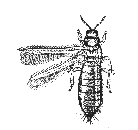Eastern Flower Thrips
Frankliniella tritici
Biology
The eastern flower thrips, I, is a tiny, yellow to
brown insect less than 1/16 inch long. Adults are attracted to flowers
of many different plants; their rasping feeding causes premature wilting
of flower parts and blossom drop, as well as fruit deformities in some
crops. Although Stannard (1968) reported that eastern flower thrips have
never been found overwintering outdoors in Illinois (overwintering in
greenhouses is presumed to occur), populations of this insect do develop
each year throughout the state as a result of long-distance migrations
from southern states on high-level winds associated with weather fronts.
Stannard (1969) also reported that immigration of thrips may occur
simultaneously with immigration of the potato leafhopper.

Eastern Flower Thrips. Actual length = 1/16 inch (1.5 mm).
Damage
Although Forbes (1892) and Slingerland & Crosby
(1914) described buttoning or blighting of strawberry fruits in
experiments in which eastern flower thrips were confined on plants
during bloom and fruit set, thrips damage to strawberries has not been
reported from the Midwest in the last few decades. As a result of
controlled studies and field observations in California, Allen &
Gaede (1963) reported that low populations of a related species, the
western flower thrips, caused no appreciable damage to strawberries, but
that very high populations caused golden brown discoloration of fruit
that rendered berries unmarketable. A recent revision of California's Integrated Pest Management for Strawberries (Strand 1994) notes that western flower thrips can in fact be
beneficial because they feed on mites, but control of this thrips is
recommended if populations exceed 10 per blossom because fruit damage
might then outweigh the benefits of predation on mites.
The 1994 strawberry crop failed to develop normally in many areas of the east central United States; berries failed to enlarge or ripen, remaining golden brown and leathery. Fruit symptoms matched those of thrips-damaged fruit described by Forbes (1892) and by Allen & Gaede (1963). In Illinois, this problem was greatest in the central portion of the state and less severe in the far south and the north. Whether or not eastern flower thrips caused these dramatic losses in 1994 cannot be determined, but several observations indicate that it did.
In 1994, eastern flower thrips were collected commonly on apple flowers in Urbana by mid-May, soon enough to cause damage to local strawberries. No monitoring was done in strawberries at that time. An earlier-than-normal immigration of potato leafhoppers was reported from many locations around the Midwest. If, as Stannard (1969) suggested, thrips and leafhoppers immigrated at the same time on the same weather system, it is very possible that an earlier-than-normal immigration of eastern flower thrips occurred throughout much of the east central U.S. in 1994, and that it coincided with strawberry bloom and fruit set in a large portion of Illinois and several other states. In "after-the-fact" evaluations, eastern flower thrips were numerous (sometimes > 40 per flower) on late blossoms in central Illinois fields where earlier fruits had failed to ripen normally. In more southern locations, fruit set may have preceded thrips immigration, allowing the crop to escape damage. In more northern locations, strawberries may not have begun to flower when thrips first arrived, causing immigrant thrips to seek other flowering plants instead of settling and building populations in strawberries.
Control
In Pennsylvania, Feland (personal communication)
reported that producers found thrips to be numerous on blossoms;
producers who used endosulfan (Thiodan), chlorpyrifos (Lorsban), or
diazinon prebloom or at early bloom incurred less damage than producers
who did not use an insecticide at that stage or used azinphosmethyl
(Guthion). A similar trend of less damage where insecticides were used
at prebloom or early bloom is supported by grower reports from Illinois.